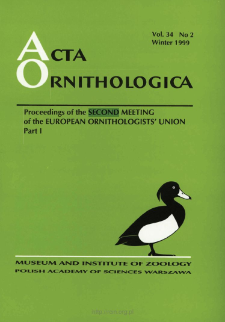- Search in all Repository
- Literature and maps
- Archeology
- Mills database
- Natural sciences
Advanced search
Advanced search
Advanced search
Advanced search
Advanced search

Object
Title: Nest predation as a limiting factor to the breeding population size of the collared flycatcher Ficedula albicollis in the Białowieża National Park (NE Poland)
Subtitle:
Acta Ornithologica, vol. 37, no. 2 ; Drapieżnictwo gniazdowe ogranicza liczebność lęgową muchołówki białoszyjej (z krytycznym przeglądem wcześniejszych hipotez) ; Nest predation on the collared flycatcher
Contributor:
Polska Akademia Nauk. Muzeum i Instytut Zoologii
Publisher:
Muzeum i Instytut Zoologii PAN
Place of publishing:
Description:
Bibliogr. p. 104-106 ; P. [91]-106 : ill. ; 27 cm ; Abstract in Polish. Taxa in Latin
Type of object:
Abstract:
This study is based on an analysis of nest-histories of 652 Collared Flycatcher nests found in natural tree cavities in the Białowieża National Park in 1988-1999. The secondary-cavity-nester Collared Flycatcher constitutes migratory single-brooded population breeding in high density in the primeval oak-lime-hornbeam (Querco/Tillio-Carpinetum) stands. Nest predation was the main reason of the breeding losses (240 nests) accounting for 91% (82%-100%) of them. Local production of fledglings was affected by nest predation caused by rodents, mustelids and Great Spotted Woodpecker. In this study a link between forest rodent cycles and the Collared Flycatcher fluctuations in number was documented. Number of produced fledglings depended on both, positively the number of the Collared Flycatcher breeding pairs in year N and negatively on the Yellow-necked Mouse density in year N. Rate of nest destruction is related to the density of the Yellow-necked Mouse recorded in BNP, while independent on the Collared Flycatcher density (nest predation limiting but not regulating). The predation pressure in some years keeps the Collared Flycatcher density at a level well below that of the potential the habitat resources (nest-sites, food). Local breeding density was shaped by fledglings productivity (breeding success) of the previous year. Earlier hypotheses concerning the Collared Flycatcher and other birds population limitation were also discussed.
Relation:
Volume:
Issue:
Start page:
End page:
Detailed Resource Type:
Format:
Resource Identifier:
Source:
MiIZ PAN, call no. P.257-37-2 ; MiIZ PAN, call no. P.4568-37-2 ; click here to follow the link
Language:
Rights:
Creative Commons Attribution BY 3.0 PL license
Terms of use:
Digitizing institution:
Museum and Institute of Zoology of the Polish Academy of Sciences
Original in:
Library of the Museum and Institute of Zoology of the Polish Academy of Sciences
Projects co-financed by:
Programme Innovative Economy, 2010-2014, Priority Axis 2. R&D infrastructure ; European Union. European Regional Development Fund
Access:
Object collections:
- Digital Repository of Scientific Institutes > Partners' collections > Museum and Institute of Zoology PAS > Scientific Journals
- Digital Repository of Scientific Institutes > Partners' collections > Museum and Institute of Zoology PAS > MIZ PAN Publications > Acta Ornithologica
- Digital Repository of Scientific Institutes > Literature > Journals/Articles
Last modified:
Oct 2, 2020
In our library since:
Jun 10, 2014
Number of object content downloads / hits:
624
All available object's versions:
https://rcin.org.pl./publication/55577
Show description in RDF format:
Show description in RDFa format:
Show description in OAI-PMH format:
Objects Similar
Walankiewicz, Wiesław
Mitrus, Cezary Walankiewicz, Wiesław Czeszczewik, Dorota Jabłoński, Piotr M.
Walankiewicz, Wiesław Czeszczewik, Dorota Mitrus, Cezary Szymura, Arkadiusz
Walankiewicz, Wiesław Mitrus, Cezary
Walankiewicz, Wiesław Mitrus, Cezary Czeszczewik, Dorota Jabłoński, Piotr M.
Mitrus, Cezary Rogala, Beata
Mitrus, Cezary
Dunajewski, Andrzej (1908–1944)

 INSTYTUT ARCHEOLOGII I ETNOLOGII POLSKIEJ AKADEMII NAUK
INSTYTUT ARCHEOLOGII I ETNOLOGII POLSKIEJ AKADEMII NAUK
 INSTYTUT BADAŃ LITERACKICH POLSKIEJ AKADEMII NAUK
INSTYTUT BADAŃ LITERACKICH POLSKIEJ AKADEMII NAUK
 INSTYTUT BADAWCZY LEŚNICTWA
INSTYTUT BADAWCZY LEŚNICTWA
 INSTYTUT BIOLOGII DOŚWIADCZALNEJ IM. MARCELEGO NENCKIEGO POLSKIEJ AKADEMII NAUK
INSTYTUT BIOLOGII DOŚWIADCZALNEJ IM. MARCELEGO NENCKIEGO POLSKIEJ AKADEMII NAUK
 INSTYTUT BIOLOGII SSAKÓW POLSKIEJ AKADEMII NAUK
INSTYTUT BIOLOGII SSAKÓW POLSKIEJ AKADEMII NAUK
 INSTYTUT CHEMII FIZYCZNEJ PAN
INSTYTUT CHEMII FIZYCZNEJ PAN
 INSTYTUT CHEMII ORGANICZNEJ PAN
INSTYTUT CHEMII ORGANICZNEJ PAN
 INSTYTUT FILOZOFII I SOCJOLOGII PAN
INSTYTUT FILOZOFII I SOCJOLOGII PAN
 INSTYTUT GEOGRAFII I PRZESTRZENNEGO ZAGOSPODAROWANIA PAN
INSTYTUT GEOGRAFII I PRZESTRZENNEGO ZAGOSPODAROWANIA PAN
 INSTYTUT HISTORII im. TADEUSZA MANTEUFFLA POLSKIEJ AKADEMII NAUK
INSTYTUT HISTORII im. TADEUSZA MANTEUFFLA POLSKIEJ AKADEMII NAUK
 INSTYTUT JĘZYKA POLSKIEGO POLSKIEJ AKADEMII NAUK
INSTYTUT JĘZYKA POLSKIEGO POLSKIEJ AKADEMII NAUK
 INSTYTUT MATEMATYCZNY PAN
INSTYTUT MATEMATYCZNY PAN
 INSTYTUT MEDYCYNY DOŚWIADCZALNEJ I KLINICZNEJ IM.MIROSŁAWA MOSSAKOWSKIEGO POLSKIEJ AKADEMII NAUK
INSTYTUT MEDYCYNY DOŚWIADCZALNEJ I KLINICZNEJ IM.MIROSŁAWA MOSSAKOWSKIEGO POLSKIEJ AKADEMII NAUK
 INSTYTUT PODSTAWOWYCH PROBLEMÓW TECHNIKI PAN
INSTYTUT PODSTAWOWYCH PROBLEMÓW TECHNIKI PAN
 INSTYTUT SLAWISTYKI PAN
INSTYTUT SLAWISTYKI PAN
 SIEĆ BADAWCZA ŁUKASIEWICZ - INSTYTUT TECHNOLOGII MATERIAŁÓW ELEKTRONICZNYCH
SIEĆ BADAWCZA ŁUKASIEWICZ - INSTYTUT TECHNOLOGII MATERIAŁÓW ELEKTRONICZNYCH
 MUZEUM I INSTYTUT ZOOLOGII POLSKIEJ AKADEMII NAUK
MUZEUM I INSTYTUT ZOOLOGII POLSKIEJ AKADEMII NAUK
 INSTYTUT BADAŃ SYSTEMOWYCH PAN
INSTYTUT BADAŃ SYSTEMOWYCH PAN
 INSTYTUT BOTANIKI IM. WŁADYSŁAWA SZAFERA POLSKIEJ AKADEMII NAUK
INSTYTUT BOTANIKI IM. WŁADYSŁAWA SZAFERA POLSKIEJ AKADEMII NAUK


































